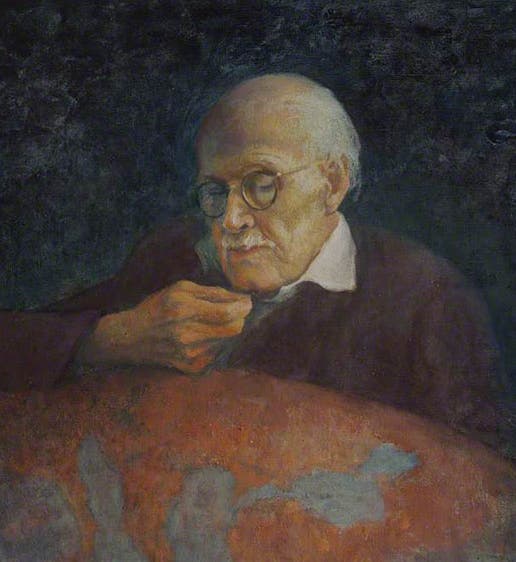Scientist of the Day - Harold Jeffreys
Harold Jeffreys, an English geologist, was born Apr. 22, 1891. Jeffreys was perhaps the leading geophysicist of the early 20th century, and in 1924, he published a book that became the bible of geophysics, The Earth: Its Origin, History, and Physical Constitution. We have four editions in our Library, including the first. In ordinary times, I would show you the title page of the first edition and perhaps a few diagrams of relevance, but all our rare books are inaccessible at the moment. So we show instead a portrait of Jeffreys by Zsuzsi Roboz that hangs in St. John's College, Cambridge, where Jeffreys taught for most of his career (first image).
Jefferys was really an exceptional geophysicist and would win all sorts of awards during his long life (he died in 1989, just short of his 98th birthday). But when it came to continental drift, Jeffreys was adamantly opposed the idea. Alfred Wegener's suggestion that continents have moved and raised mountains in the process was first aired in book form in 1915 and entered the English-speaking world in 1924, when the first English translation of Wegener’s work, The Origin of Continents and Oceans, was published. In the 1924 edition of his own book, Jeffreys, who of course read German and was already familiar with Wegener's ideas, gave the theory only a paragraph, relegated to an appendix, where he called the hypothesis "impossible," because a small force cannot push an entire continent across a sea floor, especially if there is enough resistance to raise mountains. There is nothing surprising here – most geologists at the time felt exactly the same way. What makes Jeffreys interesting is that he continued to publish new editions of his textbook right up to 1976, so we can track his changing attitude as the century progressed. And what makes him really interesting is that his attitude did not change, even as plate tectonics exploded all around him in the 1960s. In the 1959 edition, which appeared after the discovery of geomagnetic records in rocks, he now allotted 8 pages to continental drift, but he claimed that the evidence for drift is mainly paleontological, not geological, and can be explained without moving continents. He dismissed geomagnetic studies as fraught with error. In the 1970 edition, after the discovery of rifting, sea-floor spreading, subduction, transform faults, and geomagnetic reversals, his section on continental drift (he still used the term) was virtually unchanged. What he said in the last (1976) edition I cannot personally determine, since the Library's copy is out of reach for now. But according to the late and deeply lamented Hank Frankel, author of The Continental Drift Controversy (2012), Jeffreys kept plate tectonics at bay until his dying breath. It is strange how resistant to novelty even the most brilliant people can become as they grow old. That should not take away from the valuable contributions that scientists make in their prime. But I am afraid it does.
Since we have no other relevant graphics, we show you a photograph of Jeffreys in 1928, when he was in his prime, and looking ready to throw his typewriter at the photographer (second image).
Dr. William B. Ashworth, Jr., Consultant for the History of Science, Linda Hall Library and Associate Professor emeritus, Department of History, University of Missouri-Kansas City. Comments or corrections are welcome; please direct to ashworthw@umkc.edu.







